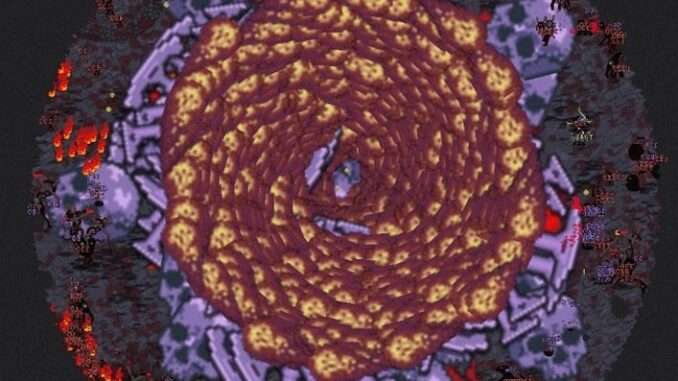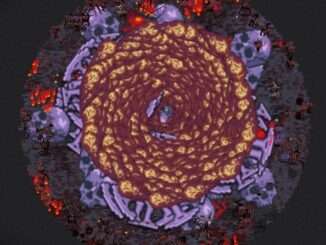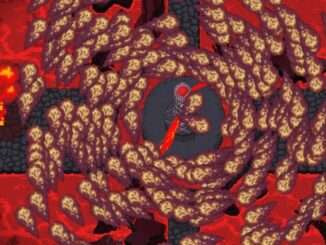
So you want to begin your exciting new job as a manager of the nine layers defense system. Excellent! But I hear you say, how do I start? Where do I start? Why does Greed hurt so much?!? This guide is designed to pick up where the tutorial left off, and assist all new employees in bludgeoning, burning, battering and otherwise beating sinners back to where they belong.
Guide to Basics
Introduction
Greetings, this guide is simply a rough cobbling together of all the thoughts I’ve had, and discussions I’ve had on the boards. Heretic’s Fork is a tough game initially, but once you understand the way it operates, it becomes much more manageable. It’s unique in that most of the difficulty comes not from lack of good cards, but from lack of tactics and understanding. Hopefully this will speed you along to becoming better, quicker, so you can tackle the challenges it has to offer.
The Starting Point
By now the game should have explained the basics, so I will try not to reiterate them. You’ve also hopefully played a game or two, likely gotten battered by level 4 (Greed) and aren’t sure what to do next. So here are the first steps:
Avoid Hellfire, and Garrisons.
There’s nothing “wrong” with them inherently, but I would call them the more difficult builds to attempt, you either need a few more cards unlocked, or a solid understanding of the game mechanics in order to make them work.
And that’s another point that you may have picked up on already: stick to a “type” as best you can. The game prioritizes increasing damage based on “Towers” or “Holy damage” etc, this is critical so that you’re not juggling cards that only benefit one of your structures at a time. So based on what you get in Limbo (the first map) make a decision and commit. You can either commit to “Towers” or “Holy” or “Unholy”, or you can commit to a much more specific “Holy Towers only”.
It’s also important to note that not all buffs affect all towers, if you hover your mouse over the tower you have in the upper left, it will tell you what kinds of buffs affect it. So for example, the Sunder tower is only affected by damage and range, meaning it won’t get benefits if you have other towers that need AOE buffs or attack speed buffs.
This is important because even though the game has helpful little arrows to show you if a card in your hand will affect one of your structures, you do NOT get that helpful tip while you are upgrading, choosing rewards, or buying cards.
Speaking of game mechanics, the next section has a bit more on that.
Mechanics You May Not Have Noticed
Some of the more complicated mechanics in Heretic’s Fork don’t make themselves readily apparent right of the bat, so here are a few that might make your first runs more fruitful:
The Deck and the Draw
The minimum deck size is 13, that includes your draw, discard, and whatever you have in the merge slot, if you have less than that at any time, the game will fill your discard pile with rocks until you are at 13. It’s good to try to stay around 13-15 as often as possible. Speaking of, if you merge something and leave it in the slot in the lower left, it will stay there until next round, so if you make a great card, but can’t afford it, or if you make a terrible card and want to merge it next turn, leave it where it is!
Skipping Rewards
Always, always always, take your rewards cards, never ever skip (until you really know what you’re doing) The reason I say this is that even if you don’t want the cards offered, if you grab the highest rarity card the game is offering, that’s simply that many cards you don’t have to waste to get a card up to that tier. Ideally, you will be using every card, or almost every card in your hand, ever turn. Personally I try to merge cards every.. single.. round.. in the first half of the game. And if you pull a blue card, even if it’s trash, you no longer have to merge 4 rocks to get that blue, you can skip right to combining it with another blue card to get a purple, it just saves steps.
Low Tier v High Tier cards
White/Green structures are reusable, there is a little X in the corner of cards that vanish, as opposed to get discarded. White and Green level structures get put into your discard pile, and can be used again in a few turns to merge with the structure you have already on the field, over and over. However, Blue/Purple/Yellow tier structures vanish after use, and you don’t get to use them again. This can be invaluable to know, because if you have multiple structure slots available you can continue to play them, merge them, and repeat.
To Merge or not to Merge
Speaking of merging, when you hover over the details of your structures in play, it will tell you what increasing it’s level will do to the structure. For example, the Sin Spotter says “Attack Speed x1/x2/x4/x8/x16” If you look at that for a minute, you may notice that the implication then, is that two level 2 towers, and one level 3 tower shoot… the same number of shots per second. The only real benefit to merging towers, is freeing up space for others, so even though it might be tempting… Don’t merge two towers you have in play unless you need that free space to play another one.
Two of a Kind
Toward the end of a run, you won’t be able to rely on a green tower coming around and upgrading it all the way to yellow, but there’s another tip here as well. I’m sure you’ve found that you can merge cards in the lower left, but what you may not have noticed, is if you merge two cards that are the exact same card, one of your choices for upgrade will be an upgraded version of that same card (if it’s unlocked). So if you can snag two green Sin Spotters, and pop them both in the merger, you are guaranteed a blue version.
Hit the Gym
Lastly, while towers are very important, don’t underestimate the usage of the buff cards, the ones that increase damage of towers, or damage of holy, or range of towers, etc. It’s essential to have at least a couple of these in your deck that you don’t upgrade, and just keep using every time you can. And as you unlock more options for your cards, you’ll find even more specific ones that increase towers but decrease garrisons, or increase unholy but decrease holy, these are incredibly cost effective, so make sure to find the ones that work for you and just keep a few of them on hand to gradually increase all the time.
Greezy, and Dealing with a Diluted Pool of Cards
At the time of writing this, there’s a discussion on whether the card pool is too diluted or not after you start to unlock cards. There are currently and additional 140-ish cards to unlock, which more than doubles your starting pool of cards. Since there is no way to permanently remove cards from a run (banish only removes that instance of the card, it does not prevent it from appearing in future shops), we’re looking at more options that make it harder to streamline a run. More powerful options, to be sure, but still more options.
Here are some things I’ve mixed into my play that has helped me win more regularly:
Luck
There’s a +20 luck modifier you can pick up from the rewards after completing a stage, and there are cards that increase your luck. Luck is, broadly, the chance to pull higher tier cards when you’re picking cards at random, like from the shops, or from rewards pools. Getting luck up to ~50 pretty much promises that you’ll be pulling yellow tier cards regularly. And on top of pulling them, if you can match two yellows you don’t need, you can reroll them, and then you get to pick from a pool of yellow cards.
Luck basically helps you bypass the whole “matching and merging” steps, you can put less focus on that and more focus on the buffs.
Shops
Mostly this applies to the final leader, Greezy, but a money route can apply to many runs regardless. The combination is the Bazaar/Jackpot and an unlock-able card Insurance, insurance adds 5 gold onto every card that’s banished, Bazaar makes a shop or is banished for 25 gold on it’s own, and Jackpot keeps adding Bazaars to your deck. Since the regular rounds don’t use money (save Greed and… Heresy? I forget which) You essentially more chances to pickup cards, and more saved up money to use during those rounds to reshuffle the cards available in the shop.
Draw
While there are more cards that dilute the pool, you do gain access to more cards with draw functions, even ones that are free, or can be used to gain energy instead. Picking up one or two and keeping them in your pool can help give you a larger hand to merge cards with and keep cycling through them. Additionally, cards like Crafter will turn all your rocks into random green cards, giving you free upgrades on all of them to get toward higher tiers of cards, basically guaranteeing you a purple every round if you can merge your whole hand.
Conclusion
Hopefully all that helps!
I will adjust this guide as I think of new things, or changes are made to the game. I feel I’ve learned this game pretty well, but I don’t claim to be an expert, so any new tips or things you think should be in here, I’m happy to take a look at.





“avoid hellfire” – funny how I was struggling getting past greed level, trying anything but hellfire, but as soon as I went all Sunder I made it past all the way to treachery.
That’s valid, but you’re not in the minority. Hellfire doesn’t have a lot of options when you first start off, lots of it is unlocked behind tasks, and aside from maybe the exploding garrison, they start with a disadvantage to the kinds of buffs they benefit from.
Fair enough. I guess I was lucky as it was my fifth or sixth run into the game. I did it on Fenriz and I wasn’t going for “Sunder only” achievement. It felt surprisingly op compared with previous runs.
Best build is just 6 Judgement towers with loads of projectile speed buffs.
Yo it’s just me or is Greezy the worst character? Buying the cards is so much worse then just upgrading it
Greezy is by far the Weirdest character, I took many attempts to get farther than Greed with them, but then once I used some of the tactics in this guide, I was literally burning through a dozen rerolls a turn by the end game, so it’s kind of a highly specialized character build
Is it just me, or are damage based powers, like triple tap, Slap and Holy Sacrifice and Golden fist terrible? Holy sacrifice exists to be banished, Golden fist has the defence of occasionally making you money, but Slap and triple tap seem worse than rocks
Hi! Do you know if adding crit chance above 100% does anything?
My gut suggests no, but I’ll be honest, I’ve never made it a point to test that, typically by the time I hit close to 100% the game is over, and I’ve not reached far enough in endless with unholy to look into it
It might work. I`ve seen sometimes 4k damage, when my dudes always crit for 2k.
But yes, it needs to be tested more.
Thanks!